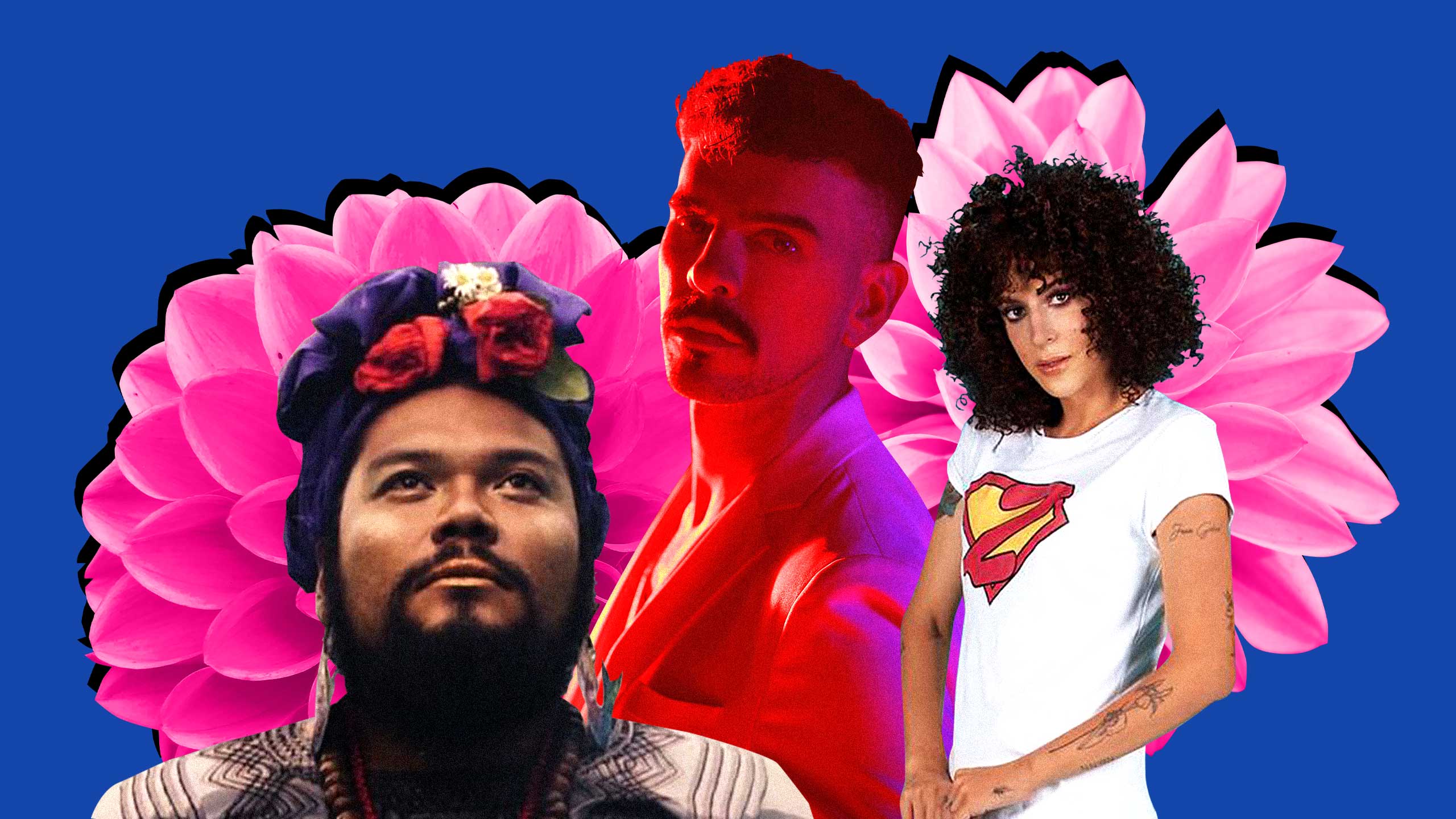Wearing exaggerated false eyelashes, heels on folkloric footwear, glittered revolutionary moustaches and pink mariachi hats, queer artists in Mexico have a knack for finding ways to put their own spin on traditional Mexican music and culture. Like an image of Mexican Revolution leaders Pancho Villa and Emiliano Zapata French kissing under a disco ball, the current rise of music from LGBTQ+ artists in Mexico is something worth celebrating twice: once for its roots, and once for its fabulousness.
There are a couple of key factors powering this creativity. Many talented artists are discontented with the current music scene, long dominated by genres like banda and norteño (more later on norteño), and so there is a desire to reinterpret the aesthetic of national pop for political reasons. Secondly, as the idea of sexual diversity catches on in Mexico, queer artists are increasingly able to find success in doing their own thing, rising up against the spirit of machismo even as homophobia remains an obstacle to their careers.
Mexican queer and trans people still face many difficulties. A 2017 national survey found that LGBTQ+ people are among the groups most discriminated against in the country. The sexual diversity advocacy group Letra S has reported that 117 LGBTQ+ people were murdered in 2019—that’s a third more than were murdered in 2018.
It’s in this context that the new queer Mexican music scene has had to make its way: one foot in an evolving culture, the other in a hostile one. In turn, the musical styles queer and trans artists use often incorporate genres that are popular among straight (buga, as we say in Mexico) audiences, rather than retreating to the sound of gay clubs. The five artists on this list channel legacies through northern music, traditional southern rhythms and guitars that evoke the romantic tradition of boleros, reimagining them as confessions of sexual dissidence.
This list, of course, falls short, considering how much is happening now in Mexico’s queer scene. But the included acts are not only making great music—they’re transforming the way Mexicans think about their national sounds.
Zemmoa
The fascinating fame that surrounds Zemmoa is due to her queer trailblazing. She burst onto the scene around 2010, when conversations about queer, trans and non-binary identities were still uncommon in Mexico. She came out as a trans woman at one of her first shows. Although her beginnings trace back to the underground scene of alternative clubs and gay bars, today she has a major presence on the Aztec musical radar and in pop culture.
In addition to modelling for brands like Diesel and Adidas, being shot by famed photographer Mario Testino and working with designer Jeremy Scott, Zemmoa is a visual artist, filmmaker, creator of her own jewelry line and an activist, using her platform to describe her trans experience. But her principal passion is music, and her four albums have been released on her own label, Zemmporio Records.
Lo que me haces sentir, released in 2021, is her latest, which led off with the singles “Mi Amor Soy Yo” (featuring Tessa Ia and Canadian electro act Trans-X) and “Pendejo.” Most of her songs are a mix of danceable synth-pop with hints of vaporwave and Latin romanticism. She’s also an amazing classically trained pianist who puts on shows that can be explosive or intimate.
Zemmoa’s self-penned lyrics show great wit—they’re love stories for the neurosis of the digital age. But she also celebrates the contradictions of being herself, using typical Mexican drama and humour as a way to question one’s own sensitivity. “Pendejo,” which can translate as “asshole,” is a hilarious example of that.
La Bruja De Texcoco (The Witch of Texcoco)
Legend has it that La Bruja De Texcoco was born on the day a healer (a person who practices healing with pre-Hispanic rituals, herbs and roots) approached the then-school teacher to reveal their future: “You are a woman. You belong to my witches.” La Bruja accepted this fate with head held high.
She traded in masculine clothes for Mexican skirts embroidered with coloured seeds and green branches, typical huipiles of the Juchitán region of the southern state of Oaxaca. With flowers in her hair held by braids that frame dramatic eyeshadow, lipstick and a sculpted beard—feminine and masculine signifiers that for a long time have defined what women and men should be in Mexico—she renounced her birth name and became La Bruja De Texcoco. She used her earnings from teaching primary school to produce her first album, De brujas, Peteneras y Chachalacas.
La Bruja De Texcoco has reimagined what LGBTQ+ Mexican artists can do. Using pop trends, dance electronics and ballads, she adapts the sounds that have shaped the history of Mexico, from pre-Columbian or New Hispanic music to regional styles such as the huapango and son jarocho by adding contemporary rhythms. Her take on typically macho music, like boleros and corridos, which date back to the Mexican Revolution, brings new generations closer to musical tradition—only with lyrics about pride, diversity and being yourself.
Miss Velvetine
Think Dolly Parton meets Los Tigres del Norte (the most respected northern male and mustachioed band in Mexico). Miss Velvetine paints her lips and parties to the rhythm of a sensuous Mexican accordion. She puts on a colourful show, but to understand her impact in the context of queer music in Mexico, it is important to briefly describe the regional music known as norteño.
The genre is mostly performed by large bands from Northern Mexico. The rhythm has a certain kinship with the country music of the southern United States, and it employs instruments such as the accordion, bajo quinto (“bass fifth”), drums, tuba and tololoche. The genre is dominated—both on the talent side and in fandom—by cisgender men. Aficionados often wear Texas-style hats, sequin-decorated jackets and cowboy boots. There have been women in norteño—like Jenni Rivera, who died in a plane crash in 2012—but they are few and far between.
The norteño lyrics and accompanying videos usually depict sexist stories, where women are sex objects in miniskirts, unleashing love and hate in equal measure. In fact, many videos from the northern region have been censored by the Mexican government for their explicit misogyny, as well as for references to the violent culture of drug trafficking. The norteño imagination is inhabited by tasteless sequins, tiger skins, mansions decorated with Greek sculptures, weapons and messages of violence.
This is where the Miss Velvetine soundtrack disrupts the north, charmingly subverting the elements of its music by taking norteño to a land of irony and flirtatious sexual diversity. Miss Velvetine defines herself as the creator of the dragteño genre. The same sequins, the same instruments, the same beat and vocal style, but brought into the field of queer camp with splashes of electronic music and even hip-hop. Her ingenious lyrics make carefree twists, suggesting, for example, that what the mustachioed men of the North really seek is to kiss each other. Miss Velvetine takes queer revenge on norteño machismo.
Flor Amargo
This artist’s work is a combination of inspiration and pride. Flor Amargo’s beginnings date back several years, when she became known as “La Loca del Metro” (“The crazy woman of the Metro”). She sang in the cars of Mexico City’s subway system to make herself known and earn a few coins. None of the passengers could ignore her.
The passion with which she interpreted both covers and original songs left no listener indifferent. Her body, possessed every time she sang, was a show of unexpected and subversive movements. From subway cars, she jumped onto the streets, where she sang classical music and cumbia verses. And from there, she went on to big stages around the world and to fame.
Amargo, who describes herself as a “queer latina warrior,” is recognized as a diverse singer who explores the experiences of the streets where she was born, making them come alive in song. She is always jumping from genre to genre, mixing classic styles such as chamber music vocalizations with rhythms and sounds popular in the working-class neighbourhoods of Mexico City. Her embrace of genres like cumbia, which might be seen as downmarket music, challenges the tragic classism that inflicts Mexican society. The characters in her songs have typically been made invisible by social pressures; she gives voice to the inhabitants of Mexico who are not always taken into account by consumerism, and who are sometimes devoured by it.
In Amargo’s performances, there is a joy, awareness and resistance that very few artists on the scene manage to achieve.
Torreblanca
On the more indie side of things, Torreblanca is a band signed by the Mexican arm of the Arts & Crafts label and led by singer-songwriter Juan Manuel Torreblanca—an artist who understands his homosexuality as a poetic exercise, allowing him to break from the mistaken belief that sexual diversity is encompassed by over-socialized athletic gay men. Formed in 2007, Torreblanca’s success may be connected to being one of the first Mexican artists to use gender-neutral terms and pronouns (which is tough in Spanish, a language that likes to gender most things), which was a way to reach all those who do not feel included under the LGBTQ+ umbrella. The band’s repertoire includes stories of characters with identities that are not specified, an audacious move in a city as complicatedly conscious of class and background as Mexico City.
Torreblanca’s sound can be defined as flawless and playful pop, perhaps with more international influences than Mexican ones. The band leader’s lyrics address the possibilities of urban characters looking for love in contaminated locations, but it’s his piano that’s the protagonist of the melodies. Juan Manuel Torreblanca’s playing guides an entire musical instrumentation that rises, as if seeking ecstasy, in the streets of Mexican cities. With a masculine voice that is not afraid of fragility, Torreblanca demonstrates tenderness and affable eroticism.


 Why you can trust Xtra
Why you can trust Xtra


